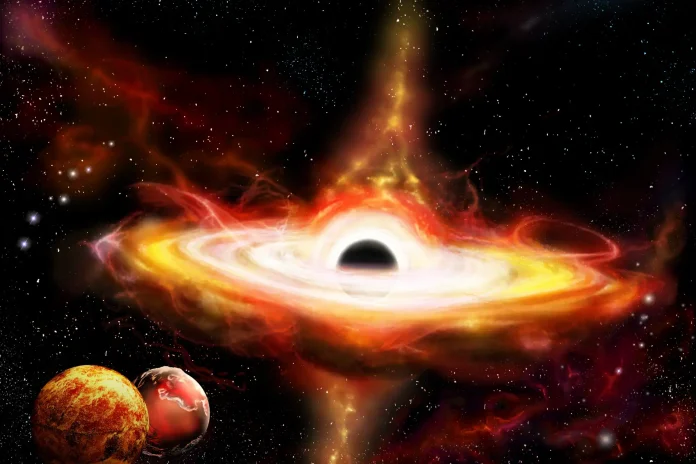Astronomers have discovered a record-breaking supermassive black hole binary in the galaxy B2 0402+379. The pair, locked in a gravitational dance, holds the title of the heaviest black hole pair ever measured, spreading across 28 billion times the mass of our Sun. This discovery, detailed in a recent study published in The Astrophysical Journal, offers new insights into the complex dynamics of black hole mergers and their challenges in their final stages.
The Record-Breaking Heaviest Black Hole Pair
The team utilized data from the Gemini North telescope in Hawaii to analyze the black hole binary within B2 0402+379. This unique system stands out for two key reasons:
Unusual Closeness: The two black holes are separated by only 24 light-years, the smallest ever directly measured for a supermassive binary. This proximity suggests an imminent merger, yet the system appears strangely blocked.
Unmatched Mass: The combined mass of the binary is about 28 billion solar masses, making it the heaviest supermassive black hole pair ever discovered. This extreme mass provides valuable clues to the system’s formation and its unexpected delay in merging.
Also check: Moon Has Entered New Lunar Anthropocene
The Mystery of the Cosmic Merger
While the proximity of the black holes hints at an approaching merger, the system has remained locked in this state for over 3 billion years. To understand the reason behind this delay, the researchers examined data from the Gemini Multi-Object Spectrograph (GMOS) to map the velocities of stars near the black holes.
“By studying the stars’ increasing velocities closer to the galaxy’s center, we were able to infer the total mass of the black holes residing there,” explains Dr. Roger Romani, co-author of the paper and a professor of physics at Stanford University.
Also check: Hidden Ocean on Saturn Moon Mimas Discovered
This analysis revealed the immense mass of the binary, which holds the key to its blocked merger. As per existing theories, supermassive black holes lose energy through gravitational interactions with surrounding stars, gradually spiraling closer until they merge. However, the total mass of this particular binary requires a much larger amount of energy loss than usual to reach the final push.
“Normally, lighter black hole pairs have enough surrounding stars to facilitate a quicker merger,” Dr. Romani adds. “But the immense mass of this pair necessitates a vast amount of stellar matter to slow their orbit. This binary has essentially cleaned its surroundings, leaving the core devoid of the necessary material for a final merger.”
What Does the Future Hold for this Binary?
The future path of this record-breaking binary remains uncertain. While the system may overcome its current stagnation and merge in millions of years, it may remain locked in its celestial position forever. If a merger does occur, the resulting gravitational waves would be a hundred million times more powerful than those produced by stellar-mass black hole mergers, potentially offering a unique glimpse into these cosmic events.
Also check: NASA Ready to Intercept God of Chaos Asteroid
One potential scenario for a future merger involves another galactic merger injecting the system with additional material, or even a third black hole, to further slow the binary’s orbit and enable a final collapse. However, given B2 0402+379’s status as a “fossil cluster,” another galactic merger is considered unlikely.
The team plans to delve deeper into the mystery by studying the gas content in the core of B2 0402+379. This analysis will provide important insights into the long-term fate of this fascinating, heaviest black hole pair and its potential to rewrite our understanding of supermassive black hole mergers.



